As I get closer and closer to my Antarctic deployment date, the trainings and prep meetings are piling up. We’ve had training on risk management, communication and leadership, bystander intervention. We have been warned repeatedly about the environmental dangers and given multiple, extensive packing lists. My boss is planning a half-day field skills training for us which will include things like how to use a generator and chainsaw safety, plus tips for navigating McMurdo Station. And all of this is in addition to the mandatory trainings at McMurdo, which will include things like knot-tying, securing a tent on the ice, snowmobile safety and repair, and who knows what else.
And yet, I can’t help but wonder… how bad could fieldwork in Antarctica really be?
I mean sure, Antarctica is dangerous. Lots of people have died there. The environment is not fit for human habitation and there are no food sources, no natural shelters, just snow and ice and wind. But we have some pretty serious infrastructure down there. The US Antarctic Program is providing people and equipment and fuel and food. As long as you aren’t stupid, the risk of death sounds pretty low to me. And we’ll have things like propane heaters and even a toilet tent (which is basically a bucket in a tent).
Sounds like absolute luxury compared to my dissertation fieldwork in Indonesia.

A much (MUCH) younger me in Betumonga, North Pagai Island, Indonesia
For my Ph.D. in physical anthropology, I studied the conservation biology and genetics of gibbons. Gibbons are small apes found only in the tropical forests of south and southeast Asia. They rarely come to the ground, instead spending most of their lives in the treetops, using their very long arms to swing from branch to branch. They are much smaller than the great apes, weighing about 12-15 lbs, except for the larger siamangs which are about twice as big. They live in small groups, usually with just one adult female and one adult male and their offspring. One of their most enchanting traits is the songs they sing at dawn, which in most species is a duet between the male and the female. These songs can travel for long distances.

Kloss’s gibbons are sometimes kept as pets in the Mentawais. This was the one time I got to physically touch one, a very young gibbon. (Primates should never be pets, please don’t do this)
I was fascinated by these apes and immediately focused on one species that was very understudied. The Kloss’s gibbon is found only in the Mentawai Islands, and before me only a few scientists had ventured into these forbidding forests to follow these primates - the last study, by Tony Whitten, had been twenty years before I went to graduate school. I soon learned why it had been so long. This small chain of four islands is located off the west coast of Sumatra, separated by the Mentawai Strait, which can be very difficult to cross due to the currents coming from the Indian Ocean. The islands are sparsely populated, primarily by indigenous groups, and are heavily forested. The Mentawai forest is an ever-wet rainforest, meaning that there is no dry season - only wet and wetter. Much of the forest has been given over to logging operations, though about half of the largest island, Siberut, is a protected national park. There are few roads on the islands and most of the ones that do exist were built by logging companies. Travel into the interior, especially in Siberut, is via dugout canoe. The air is always hot, humid, and full of mosquitoes. The plant life is covered in spikes and the hilly terrain is steep and muddy.

Posing with a family in Siberut
While the tropical rainforest is pretty much the total opposite of Antarctica, it is nevertheless a very difficult and dangerous place. And the Mentawais are very isolated. If I had broken my leg, for example, it would have taken several painful days to get me out of there - no medevac flight would have come to get me. In the early 2000s, there was no internet, no cell phone service, no way of getting in touch with the outside world. There were very few other researchers in the Mentawais - it was great to meet up with them and stay at their research locations when I could, but I was surveying several different locations throughout all four islands so I was usually on my own. I basically just showed up, met with local people, hired assistants and… off we went, into the forest.

Dinner with my field assistants in Sipora
Looking back, I cannot believe I was allowed to do this. I had no training whatsoever, beyond a previous 2-month stint in Sulawesi as a field assistant to a professor studying tarsiers and a summer studying the Indonesian language at the Southeast Asian Studies Summer Institute at the University of Wisconsin. I had no safety training, no survival training, no first aid training, basically no field skills, no cultural sensitivity training, absolutely nothing. This was typical in Anthropology, or at least it was 25 years ago. I don’t know if it is still like that. But it is worlds away from the preparation I am getting for Antarctica. Maybe it’s because if I die in Antarctica, the United States Antarctic Program is responsible for me. But if I got myself killed in Indonesia, well, I was just some dumb grad student.
Who knows. Maybe I’ll get to the Allan Hills and immediately decide that yep, they were right, this is way worse than Indonesia. Humans aren’t supposed to be there, after all. But maybe it will be wonderful.
Other things occupying my brain this week:
Reading: Just finished Under the Whispering Door by T.J. Klune. Such a sweet book! Perfect for fans of The Good Place (have I mentioned that my dogs are named Eleanor and Chidi?).
Watching: Looking forward to seeing some local theater tonight! We’re going to a performance of Blithe Spirit at the Albany Civic Theater.
Wearing: Cozy sweatshirts! FALL IS HERE!
Drinking: Bourbon by New Dawn Distilling. I worked with Dawn in the Ketterson lab when I was a postdoc at Indiana University, and I like to think I had a very very tiny part in her new direction, as I founded the Bloomington Indiana LUPEC chapter (Ladies United for the Preservation of Endangered Cocktails) and we drank a LOT of cocktails together. I can’t wait for the release of her rye whiskey! Check out her webpage and support a black woman-owned business.
